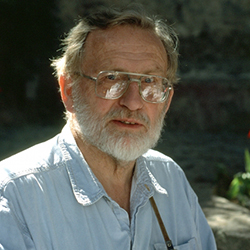
| Vol.
XXIX No.
2 November / December 2016 |
| contents |
| Printable Version |
In Memoriam
George Rathjens
I first met George Rathjens, who recently died at the age of 90, when I was thinking about applying to MIT’s Defense and Arms Control Studies (DACS) program for graduate school. Little did I know then that this overly tall chemist with a jungle of an office would be my dissertation chair, advocate, squash partner, and inspiration.
By the time I reached DACS, now the Security Studies Program (SSP), George had already accomplished more than his new graduate student could hope to achieve in his entire career. The Fairbanks, Alaska native travelled east to attend college at Yale and then back to the West for a PhD at the University of California at Berkeley. He entered government in the Eisenhower administration with his mentor, George Kistiakowsky, who had been appointed Science Adviser. For the next many years, George continued his service to the U.S. government with a focus on nuclear weapons, including the Advanced Research Projects Agency (ARPA), the Weapons Evaluation Group at the Department of Defense, the U.S. Arms Control and Disarmament Agency (ACDA), and the Department of State.
Following his government service, George made his way to MIT to help found the Defense and Arms Control Studies Program, along with his dear colleagues and friends Jack Ruina and Carl Kaysen. While at MIT, George attracted a devoted following of graduate students.
He also scared more than one of them. He was often direct and unafraid of arriving at and expressing unpleasant or unpopular conclusions. More than once, these conclusions – say about a graduate student’s future prospects – were not always appreciated.
For most of us, however, George was a delight. He fit easily with MIT’s scientific culture, a style of inquiry that was informal, non-hierarchical, and curious. If you were a first-year graduate student – even an undergraduate – and disagreed with him and made the better case, well then so be it. If anything, I think he most welcomed those moments.
George’s writing typically focused on real-world problems and appeared in more accessible journals such as Scientific American. He wrote on a variety of topics, including nuclear power, arms races, and the intersection between the environment and conflict. Most recently, he was working with Ron Siegel on the subject of climate change. This latter project was quintessentially Rathjens, insofar as it arrived at a difficult conclusion no one wants to hear, namely, that we may have passed the point of no return.
Outside of MIT, he was a tireless advocate of peace and disarmament. From 1998 to 2002, he was General Secretary of the Pugwash Conferences on Science and World Affairs, winner of the Nobel Peace Prize. He also served as chair of the Council for a Livable World, chair of the Federation of American Scientists, and was an active member of the American Academy of Arts and Sciences and its committee on international security.
As a friend and colleague, George had an irrepressible sense of humor, though expressed in a style so dry that one might miss it if not for the twinkle in his eye. I think he loved making mischief, intellectual and otherwise.
He was also a man of action. When I went out to visit him in Lexington during those last months, I made him re-tell the story of the time he was hiking with a group in South America and was set upon by robbers, one of whom was armed with a pistol. From his perch in the back of the group, he dove onto the gun-wielding assailant and knocked the weapon away (though, as he reported it, he actually tripped in the process and more or less fell on him). The two robbers ran off, and the day was saved.
In the last few years George was largely confined to his bed because of terrible back pain, but he nevertheless maintained his spirit and intellectual curiosity. On what would turn out to be my last visit, we agreed that when I returned next, I would bring a problem or project that we could work on together. I later decided that I would seek his counsel on the problem of North Korea, as frustrating and difficult a challenge as there is in the world today. Unfortunately for me and for the rest of us, I never got that chance. Still, it is hard to be too sad. His was a life well lived until the very, very end. He pursued it with integrity and authenticity and a sense of humor. One could only hope to do as well.
| Back to top | |
| Send your comments |
| home this issue archives editorial board contact us faculty website |
